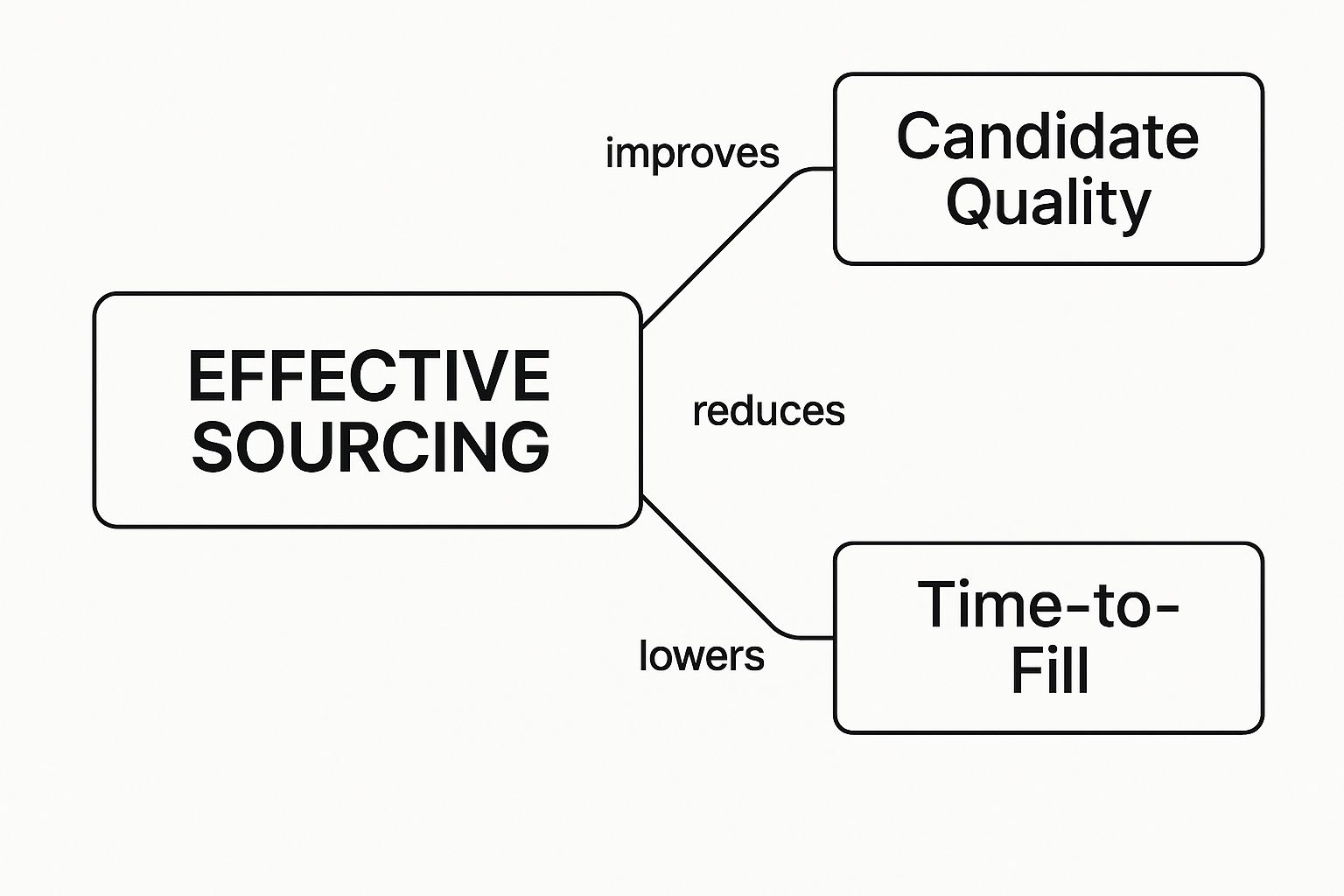Think of a talent scout for a sports team. They don't just sit in their office waiting for athletes to send in their resumes. They're out in the field, actively looking for promising players, building relationships, and identifying future stars long before they hit the open market. That, in a nutshell, is the essence of sourcing in recruitment.
It’s the proactive hunt for qualified candidates, especially those who aren't even looking for a new job. Instead of just waiting for people to knock on your door, you go out and find the best talent wherever they are.
What Is Sourcing in Recruitment and Why It Matters
Let's say your company has an urgent need for a highly specialized software engineer. If your entire strategy is posting a job ad on a few boards, you're basically fishing in a very small, crowded pond, hoping the perfect candidate happens to swim by at that exact moment.
Sourcing in recruitment is about deciding to fish in the entire lake. It's the strategic process of identifying, engaging, and building relationships with potential candidates, regardless of whether they're actively job hunting. This is the fundamental difference between simply reacting to applicants and proactively hunting for talent.
This proactive mindset completely changes how you build your team. Instead of starting from scratch every time a role opens up, sourcing allows you to create a continuous pipeline of qualified, pre-vetted people. Many of these are passive candidates—professionals who are employed, doing well, and not scrolling through job boards. However, they might be open to a compelling opportunity if it's presented in the right way. Tapping into this hidden talent pool, which makes up an estimated 70% of the global workforce, gives your company a massive competitive advantage.
Building a Foundation for Growth
Great sourcing isn't just about filling today's open req; it's a long-term play that strengthens your entire organization. When you consistently find and connect with top professionals in your industry, you build a talent community that sees your company as a desirable place to work. This directly fuels better business outcomes.
The right sourcing strategy is the engine that drives key hiring metrics, as you can see below.

As this illustrates, a powerful sourcing function leads directly to higher-quality candidates, a faster hiring process, and lower overall costs.
Proactive Sourcing vs Reactive Recruiting
To really grasp the difference, it's helpful to see the two approaches side-by-side. One is a waiting game; the other is a strategic hunt.
| Aspect | Proactive Sourcing | Reactive Recruiting |
|---|---|---|
| Timing | Continuous, long-term process | Starts when a job becomes vacant |
| Candidate Pool | Entire market (active & passive) | Primarily active job seekers |
| Approach | Hunting: Actively seeking talent | Fishing: Waiting for applications |
| Talent Quality | Targets top performers, regardless of status | Limited to who applies |
| Candidate Focus | Relationship-building, personalized outreach | Screening incoming applications |
| Goal | Build a talent pipeline for future needs | Fill an immediate open position |
The table makes it clear: while reactive recruiting is necessary for managing inbound interest, proactive sourcing is what gives you control over your talent pipeline and, ultimately, your company's future.
The Strategic Value of Sourcing
Let’s be crystal clear: sourcing is so much more than just endlessly scrolling through LinkedIn profiles. It's a strategic function that blends research, marketing, sales, and relationship management. A skilled sourcer dives deep into the company's long-term goals to identify people who can help achieve them, sometimes even before a formal job description is written.
Sourcing shifts the hiring mindset from a short-term transaction (filling a seat) to a long-term investment (building a bench of top-tier talent). This forward-thinking approach is what separates market-leading companies from everyone else.
By investing in a dedicated sourcing function, you unlock some powerful benefits:
- Access to Better Talent: You're no longer restricted to the 30% of the workforce that's actively looking. You can pinpoint and pursue the absolute best person for the role.
- Reduced Time-to-Fill: Having a warm pipeline of interested, qualified candidates means you can fill roles much faster, minimizing the productivity gaps that hurt your teams.
- A Sharper Competitive Edge: Getting to top performers before your competitors even know they might be available is a game-changer. You're not just hiring; you're securing a market advantage.
For any organization that's serious about winning the war for talent, mastering sourcing in recruitment is simply non-negotiable. It’s the engine that powers a resilient, high-performing, and successful workforce.
Essential Sourcing Methods and Channels

Alright, we've covered the "what" and "why" of sourcing. Now let's get into the "how"—the practical methods and channels you'll use to find great people. Think of it this way: if you only fish in one pond, you'll only catch one type of fish. Relying on a single job board is a surefire way to build a homogenous talent pool.
A truly effective sourcer builds a multi-channel strategy. It's about knowing where different types of talent hang out online and understanding how to connect with them there. Let's break down the most powerful approaches.
Digital Search and Professional Networks
This is the bread and butter of active sourcing—proactively finding candidates where they live and work online. It’s less about posting a job and waiting, and more about going on a targeted hunt.
-
Boolean Search: This is every great sourcer’s secret weapon. It’s a way of using simple commands like AND, OR, and NOT to craft incredibly precise searches. For instance, a string like ("Software Engineer" OR "Developer") AND "FinTech" AND "mobile" AND (iOS OR Android) NOT "Manager" helps you zero in on engineers with specific mobile and FinTech skills, while filtering out anyone in a leadership role.
-
Professional Networks: LinkedIn is the undisputed giant, with over 90% of recruiters using it. But don't stop there. For developers, a place like GitHub is a goldmine. For designers, Behance is essential. The key is to think beyond the obvious and go where your ideal candidates showcase their work.
The real goal isn't just to find a profile. It's to find proof of someone's passion and skill. A well-maintained GitHub repository or a thoughtful, detailed answer on Stack Overflow often tells you more about a candidate's real-world abilities than a polished resume ever could.
These direct search methods are the foundation of modern sourcing, giving you the precision needed to find exactly who you’re looking for.
Engaging with Niche Communities
Where do the best professionals talk shop? They gather in communities built around their specific expertise. Tapping into these spaces is less about advertising and more about becoming part of the conversation.
Think of it like joining a club for a hobby you love. You don't just show up and start yelling about what you need; you listen, you contribute, and you build genuine relationships. This approach takes patience, but it’s how you connect with passive talent who would ignore a generic recruiting message.
Where to Find These Communities:
- Reddit: Subreddits like r/ExperiencedDevs or r/marketing are full of candid, high-level discussions.
- Stack Overflow: A must for any technical role. You can spot true experts by the quality and clarity of their answers to complex problems.
- Industry Slack/Discord Channels: Many professional fields have vibrant, private communities for networking and sharing knowledge.
By becoming a credible member of these groups, you gain access to a pool of talent that is virtually invisible to other recruiters.
Leveraging Automation and Internal Resources
Great sourcing isn't just about working harder; it's about working smarter. This means using technology to handle the repetitive stuff so you can focus on what matters: building human connections. For any company looking to get more efficient, learning the basics of business process automation can be a game-changer for complex workflows like recruiting.
And sometimes, the best talent is already within your reach. Don't forget to look inward.
-
Referral Programs: Your employees are one of your best sources for new hires. People they recommend are often a great cultural fit, and referrals consistently have the highest applicant-to-hire conversion rates. They are pre-vetted by someone you already trust.
-
Your Applicant Tracking System (ATS): That database of past applicants isn't a graveyard—it's a treasure chest. It’s filled with "silver medalists" and other qualified people who were already interested in your company. Re-engaging with this internal talent pool is one of the most cost-effective sourcing tactics you can use.
By combining direct search, authentic community engagement, and smart internal tools, you build a powerful, multi-channel sourcing engine that consistently uncovers top-tier candidates.
The Power of Global Sourcing Strategies

If your sourcing is stuck within a 50-mile radius of your office, you're intentionally ignoring a world of talent. In an era where remote work has torn down geographical walls, limiting your search to local candidates is like insisting on using a flip phone in a smartphone world. Sure, it works, but you're missing out on incredible capabilities.
Global sourcing expands your talent map far beyond city limits and national borders. It’s a strategic choice to find the absolute best person for the job, not just the best person who happens to live down the street. This approach transforms sourcing in recruitment from a local search into a worldwide talent hunt.
This isn’t just a passing trend; it's a smart response to talent scarcity. When you can't find that specialized engineer or data scientist in your own backyard, a global strategy opens up thriving tech hubs on every continent. It’s a powerful way to build a team that's more diverse, innovative, and resilient.
Embracing a Truly Global Mindset
Adopting a global sourcing strategy demands a real shift in perspective. You're no longer just hiring an employee; you're building a distributed team. This means moving beyond a single-country mindset and embracing both the complexities and the massive opportunities that come with an international workforce.
The global recruitment market has certainly faced some economic headwinds, making candidates more cautious and slowing down hiring in some sectors. Even so, the push toward international talent is only getting stronger. One recent analysis found that a staggering 71% of teams have recruited internationally. Even more impressively, 87% of employers successfully fill at least four out of every ten roles with talent from outside their local area. You can read more on the global recruitment market from Bullhorn to see how companies are adapting.
This isn't just theory. The data shows that global sourcing is a practical, effective solution that companies are using right now to solve local talent shortages.
Navigating the Challenges of Global Sourcing
Of course, hiring across borders brings its own unique set of hurdles. It's critical to face these head-on with a solid plan instead of just hoping they’ll work themselves out. Ignoring them can quickly lead to compliance headaches, communication breakdowns, and friction within the team.
Key Considerations for Global Talent:
- Cultural Nuances: Communication styles, professional etiquette, and workplace expectations can differ dramatically. Success hinges on empathy and a genuine willingness to learn and adapt.
- Time Zone Differences: Managing a team spread across the globe requires deliberate communication strategies. Think asynchronous updates and flexible meeting times.
- International Labor Laws: Every country has its own rules for contracts, benefits, and payroll taxes. Navigating this web requires either legal expertise or a partnership with a global employment platform.
Overcoming these obstacles is the key to unlocking the immense potential of a global workforce. With the right preparation, these challenges become simple operational tasks.
Adopting a global sourcing strategy is the ultimate commitment to hiring for skill and potential above all else. It declares that talent, not geography, is the primary factor in building a world-class team.
How Technology Makes Global Sourcing Possible
Just a decade ago, managing a globally distributed team was a logistical nightmare reserved for the biggest corporations. Today, technology has made it accessible to companies of all sizes. Advanced tools and platforms are now the backbone of any effective international hiring strategy.
Platforms for video interviews, collaborative project management, and instant messaging have made physical distance almost irrelevant for many roles. Better yet, Employer of Record (EOR) services can handle the messy details of international payroll, benefits, and legal compliance, letting you hire someone in another country without setting up a legal entity there. For companies looking to expand their reach, exploring partners who are among the top companies in India offering staffing and recruiting services can provide direct access to specialized talent pools.
By embracing these tools, you can focus on what you do best: finding and engaging exceptional people, no matter where they are in the world. This tech-enabled approach is what makes modern global sourcing in recruitment not just possible, but incredibly powerful.
Using AI and Technology in Modern Sourcing

Let's be honest: when we hear "AI in recruiting," it's easy to picture robots taking over our jobs. But that's not what’s happening. Instead, think of AI as the ultimate research assistant—one that never gets tired, bored, or needs a coffee break.
This assistant takes on the most grueling parts of sourcing, like digging through thousands of online profiles or doing the initial pass on a flood of applications. This frees you up to do what humans do best: build real relationships, gauge personalities, and have meaningful conversations with top-tier candidates.
And it’s not just about doing things faster; it’s about doing them smarter. AI is now a go-to for initial candidate screening, and the results are pretty stunning. Companies using AI-powered assessments have cut their hiring cycles by an incredible 46%. You can explore more of these game-changing hiring and recruiting trends from TalentLMS.
Ultimately, this technology shifts a sourcer's role from a manual data-entry clerk to a strategic talent advisor.
How AI Enhances the Sourcing Process
So, what does this AI "assistant" actually do day-to-day? In a nutshell, it chews through massive amounts of data to spot patterns and clues that a person could easily miss. This translates into finding better-suited candidates, faster.
Here's how it plays out in the real world:
- Intelligent Profile Matching: AI algorithms can scan millions of profiles across countless platforms, matching skills and experience to your job description with a level of accuracy that’s tough to replicate by hand.
- Predictive Analytics: This is where it gets really interesting. Some tools can analyze a professional's career path and digital footprint to predict their likelihood of being open to a new role—even if they haven't updated their LinkedIn profile to "Open to Work."
- Bias Reduction: By programming AI to focus strictly on objective criteria like skills, experience, and qualifications, you can sidestep the unconscious biases that inevitably sneak into manual screening. This naturally leads to a richer, more diverse pool of talent.
These technologies work quietly in the background, serving up a pre-vetted list of high-potential people. This lets you jump straight to the most important part: outreach and engagement.
The true power of AI in sourcing is its ability to augment human intelligence, not replace it. It handles the 'what' and 'where'—finding the right people—so that recruiters can excel at the 'who' and 'why'—understanding their motivations and potential.
By providing data-backed recommendations, these tools empower sourcers to make sharper, quicker decisions. To really unlock this potential, it helps to build a solid framework for data-driven decision-making in your organization.
Key Tools Driving Modern Sourcing
The market is buzzing with tech built to make sourcing more effective. While the sheer number of options can feel overwhelming, most tools fall into a few key categories that work together to form a powerful talent acquisition tech stack.
By looking at where companies are spending their money, we can see what's truly essential.

This data shows that while job boards are still a major line item, Applicant Tracking Systems (ATS) and specialized sourcing tools are becoming non-negotiable for any modern recruiting team.
Here are the essential technologies you'll encounter:
- AI-Powered Sourcing Platforms: Think of these as your digital headhunters. They actively scour the web, professional networks, and social media to pinpoint passive candidates who tick all your boxes. They often surface contact details and insights to help you craft a truly personal first message.
- Smart Applicant Tracking Systems (ATS): A modern ATS is so much more than a digital filing cabinet. The best ones can automatically parse resumes, rank applicants, and even "rediscover" great candidates from past searches who are a perfect fit for a new opening.
- Recruitment CRMs (Candidate Relationship Management): If an ATS is for managing active applicants, a CRM is for cultivating future ones. These systems are designed for long-term nurturing, helping you build talent pipelines, automate follow-ups, and keep promising candidates warm until the right opportunity comes along.
When you combine these technologies, you create a sophisticated and highly efficient sourcing engine. This tech-forward approach to sourcing in recruitment enables teams to find better candidates in less time, drive down hiring costs, and secure a major advantage in the war for talent.
Crafting Outreach That Actually Gets a Response
So you’ve found the perfect candidate. Great. But that’s only half the battle. If your outreach message reads like every other boilerplate template, it’s going straight to the trash. The top talent you’re chasing gets dozens of these messages every week. To stand a chance, your approach has to be different.
Think about it this way: a generic message is junk mail. It's impersonal and instantly forgettable. A thoughtfully personalized message, on the other hand, is like a handwritten note. It proves you’ve done your homework, you see what makes them unique, and you genuinely value their skills.
Your goal isn’t just to blast out a job opening. It’s to start a real conversation that makes someone feel seen and respected. That’s how you turn a passive candidate into an engaged applicant—a core skill in modern recruiting.
The Anatomy of a Powerful First Message
A truly great outreach message boils down to three things: a hook, a connection, and a simple, low-effort ask. Nail these, and you'll see your response rates climb. Flub them, and you're just contributing to inbox noise.
Let's break down what makes a message impossible to ignore.
-
The Hook: Start with Them, Not You. Never, ever lead with, "I have a great opportunity for you." Instead, kick things off with a specific, genuine compliment about their work. This immediately shows you've put in the effort.
-
The Connection: Bridge Their Work to Your Need. Right after the hook, briefly explain why their unique experience caught your eye for this specific role. You have to connect the dots for them so they see the fit without having to work for it.
-
The Ask: Make It Easy to Say Yes. This is key. Don't ask for a resume or tell them to fill out a lengthy application. Your only goal right now is a conversation. A simple, "Would you be open to a brief, informal chat next week?" is perfect.
This structure completely changes the dynamic. You're no longer a random recruiter with a job description; you're a peer initiating a warm conversation.
A LinkedIn study found that personalized messages are significantly more likely to get a response. In fact, crafting a custom message can boost response rates by up to 30% over generic templates.
This simple act of personalization is probably the single most effective thing you can do to get better results.
Real-World Examples: Good vs. Bad
Let’s compare two outreach messages for the same Senior Product Manager role. One is destined for failure, while the other is almost guaranteed to get a reply.
The Ineffective Message (The Template)
"Hi [Candidate Name], I came across your profile and was very impressed with your background. We are hiring for a Senior Product Manager role at a fast-growing tech company that I think you would be a great fit for. Are you available to connect this week to discuss? You can see the job description here."
Why it fails:
- It's completely generic. "Impressed with your background" is a meaningless platitude.
- It puts the burden on the candidate to click a link and read a job description to figure out if it's relevant.
- It screams "mass email."
The Highly Effective Message (The Personal Touch)
"Hi Jane, I just finished reading your article on Medium about transitioning from B2C to B2B product management—your point about prioritizing user onboarding for enterprise clients was spot-on. We're building out a new enterprise product, and that specific experience is exactly what we’re looking for. Would you be open to a brief, informal chat next week to see if it piques your interest?"
Why it works:
- The hook is specific, genuine, and shows real research.
- It clearly connects her expertise to a real business need.
- The ask is low-pressure and frames the conversation around her potential interest.
The Art of the Strategic Follow-Up
Even the best-written message can get lost in a busy inbox. That’s why a polite follow-up is so critical. There’s a fine line between being persistent and being a pest, but respectful persistence shows you’re serious.
Here’s a simple framework for following up without being annoying:
- Give it time. Wait 3-5 business days before your first follow-up.
- Keep it short and sweet. A simple note to "bump" your original message to the top of their inbox is often enough.
- Add value if you can. If there’s a new company milestone or a relevant article you can share, include it.
- Know when to walk away. If you haven’t heard back after two or three attempts, it’s time to move on. Don't burn a bridge.
Mastering outreach is a game of research, empathy, and clear communication. When you stop relying on templates and start focusing on genuine, human-to-human connection, you'll see a massive difference in your results.
Of course. Here is the rewritten section with a more natural, human-expert tone.
Measuring Your Sourcing Success with Key Metrics
So, how do you know if your sourcing efforts are actually working? You can't just go by gut feeling. If you want to get better at sourcing in recruitment, you have to track your results. It’s a simple truth: what gets measured gets improved.
Without solid data, you’re just guessing. You can’t prove the value of all that hard work you're putting in, and you won’t know which of your strategies are hitting the mark. Tracking the right metrics turns sourcing from a shot in the dark into a repeatable, predictable process.
Core Metrics for Sourcing Effectiveness
You don't need a hundred different data points to get started. A few essential metrics will give you a clear picture of how your sourcing function is performing.
-
Source of Hire: This one is non-negotiable. It tells you exactly where your new hires are coming from. Was it that brilliant candidate from your referral program, someone you found on LinkedIn, or a great applicant from a niche job board? Knowing this lets you put your time, energy, and budget into the channels that actually deliver, and cut the ones that don’t.
-
Time to Fill: This is the classic recruitment metric. It’s the number of days from when a job is officially opened to when a candidate signs the offer letter. Great sourcing builds a pipeline of ready-to-go talent, which can drastically shorten this timeline. A shorter Time to Fill means less downtime for the team and gets projects moving forward faster.
Think about the impact. When you can walk into a meeting and show that your proactive sourcing cut the average Time to Fill by 25%, you're speaking the language of business. You're demonstrating how sourcing directly helps the company get crucial work done.
These aren't just numbers for a report; they're proof of your strategic value.
Analyzing the Quality of Your Pipeline
Getting people in the door quickly is one thing, but are they the right people? The real goal of sourcing is to elevate the quality of candidates in your pipeline. A few key metrics can tell you exactly how well you're doing.
Here’s a breakdown of the numbers that really matter when you're evaluating the effectiveness of your sourcing pipeline.
Essential Sourcing Performance Metrics
| Metric | What It Measures | Why It's Important |
|---|---|---|
| Submission-to-Interview Ratio | The percentage of candidates you present to a hiring manager who get invited to an interview. | A high ratio is a great sign. It means you have a solid understanding of the role and are finding people who are a genuine fit. |
| Interview-to-Offer Ratio | The percentage of candidates who interview that end up receiving a job offer. | This tells you a lot about the quality of talent making it through the later stages. It shows they're not just good on paper. |
| Offer Acceptance Rate | The percentage of candidates who say "yes" after you've extended an offer. | A high acceptance rate means you’re doing more than just finding talent; you’re building relationships and selling the opportunity effectively. |
When you put all these metrics together, you get a complete story. Source of Hire tells you where to find talent, Time to Fill tells you how fast you can engage them, and your Offer Acceptance Rate shows how well you can close them. This is the data that will help you constantly fine-tune your approach and become a truly exceptional sourcer.
Sourcing Questions We Hear All the Time
Even after you get the basics down, you're bound to run into some real-world questions when you start sourcing. That’s perfectly normal. Sourcing is a hands-on discipline, and the best learning happens when you move from theory to practice.
Let's tackle a few of the most common questions that pop up. Think of this as your go-to guide for those "what do I do now?" moments.
What Is the Difference Between a Sourcer and a Recruiter?
This is probably the number one question people ask, and getting the distinction right is key. Here’s an analogy I like to use: imagine you’re putting together a championship-winning sports team.
The sourcer is the scout. They're out there watching games, digging through stats, and networking to find gifted athletes who aren't even on the market yet. Their entire focus is on identifying and building relationships with top-tier talent.
The recruiter is the head coach and general manager rolled into one. They take the scout’s list, run the tryouts (interviews), negotiate the contracts (offers), and ultimately convince the player to join the team.
While a recruiter can certainly do their own scouting, a dedicated sourcer specializes in that critical first step: finding and engaging people who aren't actively looking.
How Long Should You Spend Sourcing for One Role?
Ah, the "how long is a piece of string?" question. There’s no single right answer because it all comes down to the role's difficulty and what the talent market looks like. You might find ten great customer service reps in an afternoon, but finding a machine learning engineer who specializes in a niche industry could easily take weeks.
As a rule of thumb, I always recommend "time-boxing" your initial search. Block out a solid 4-6 hours of focused, uninterrupted time to build your first quality list of candidates. After that initial deep dive, you can switch gears and spend just a few hours a week keeping that pipeline warm as you start your outreach.
This method keeps you from getting stuck in a never-ending sourcing rabbit hole while ensuring you have a strong pool of talent to work with from the get-go.
Is Sourcing Only for Hard-to-Fill Technical Roles?
Not at all. This is a common misconception. While sourcing got its reputation from the intense demand for tech talent, the strategy is incredibly effective for any role where you can't afford to compromise on quality.
Think about it. Do you want the best possible sales leader? A truly visionary marketing director? A financial analyst who sees things others miss? Of course you do.
Proactive sourcing is your ticket to hiring the best person out there, not just the best person who happened to see your job ad. It gives you a massive advantage for any strategic hire that can really move the needle for your business, no matter the department.
Ready to build a world-class team with a strategic sourcing partner? Zilo AI offers specialized manpower services to connect you with highly skilled professionals across any sector, from IT and healthcare to finance. Streamline your hiring and accelerate growth by visiting us at Zilo Services.

